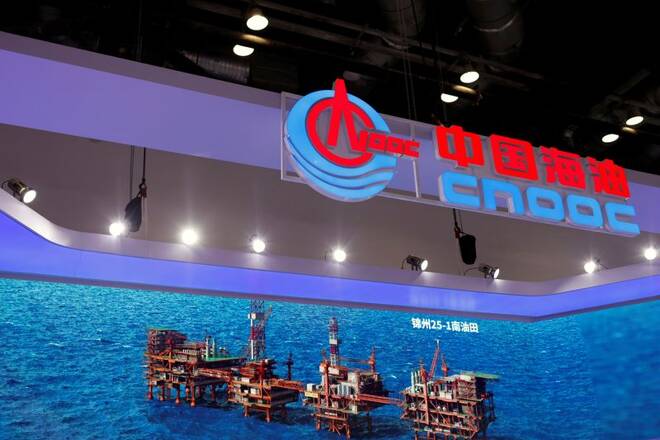Advertisement
Advertisement
Factbox-China’s energy investments in Russia
By:
By Chen Aizhu and Andrew Hayley BEIJING (Reuters) - Chinese state energy giants have made a number of multi-billion dollar investments in Russia, one of China's top oil and gas suppliers, across various stages of the energy supply chain.
By Chen Aizhu and Andrew Hayley
BEIJING (Reuters) – Chinese state energy giants have made a number of multi-billion dollar investments in Russia, one of China’s top oil and gas suppliers, across various stages of the energy supply chain.
The partnership has only grown in importance as an isolated Moscow looks to reroute supplies away from Europe, and Beijing increasingly focuses on its own domestic energy security concerns.
Below are the main investments by the Chinese government, key state-owned energy companies and their listed vehicles, based on company releases and Reuters reports.
2005: Sakhalin-3 Veninsky oil project
Russian oil giant Rosneft and Sinopec agreed to jointly explore the Sakhalin-3 Veninsky block during a visit by China’s then-president Hu Jintao to Moscow in 2005. It became China’s first energy project in Russia.
Sinopec has owned 25.1% of the project since 2007, with the remainder controlled by Rosneft.
Since 2009, Sinopec has owned 49% of Russia’s Udmurneft oilfield, also controlled by Rosneft. It was then Sinopec’s largest oil-producing asset outside China.
2014: Yamal LNG
In 2014, PetroChina bought a 20% stake in the $27 billion Yamal LNG project, a Russian LNG export facility in the Arctic operated by Russian gas producer Novatek.
Novatek holds 50.1% of the 16.5 million tonne-per-year (tpy) project, which began operation in late 2017. TotalEnergies holds 20% and China’s state-backed Silk Road Fund 9.9%.
2014: Power of Siberia pipeline
Following a 2014 deal between Gazprom and PetroChina valued at an estimated $400 billion, Russia began selling gas from the Yakutia region to China via the 3,000km Power of Siberia pipeline in December 2019.
The pipeline is expected to deliver its full capacity of 38 billion cubic metres (bcm) per year by 2027, two years later than initially scheduled.
A second pipeline, the Power of Siberia 2, has been proposed to bring gas from the Yamal peninsula to China via Mongolia. Gazprom is aiming to start delivering gas through the pipeline by 2030, with an expected capacity of 50 bcm per year.
2015: Sibur
China’s state-run Silk Road Fund bought a 10% stake in Russia’s top petrochemical firm Sibur in 2016 after Sinopec acquired 10% in late 2015, according to Sibur.
2017: Beijing Gas
In June 2017 Beijing Gas Group Co, the dominant natural gas distributor for the Chinese capital Beijing, closed a deal to pay $1.1 billion for a 20% stake in Rosneft subsidiary Verkhnechyonskneftegaz, which produces oil and gas in eastern Siberia.
2019: Arctic LNG 2
In 2019 China’s CNOOC Ltd and PetroChina agreed to buy a combined 20% stake in the $25.5 billion Arctic-2 liquefied natural gas project led by Novatek.
Novatek has a 60% stake in Arctic LNG 2, while TotalEnergies holds 10% and Japan Arctic LNG – a consortium of Mitsui & Co and state-run JOGMEC – the final 10% stake.
The Japanese and French players froze their investment in the facility in March last year following the imposition of sanctions on Russia, with TotalEnergies no longer booking reserves from the project.
The 19.8 million tpy project, one of the world’s largest, is expected to export its first LNG cargo in December this year under the first train, with the second and third starting by 2024 and 2026.
2019: Amur Gas Chemical Complex (Amur GCC)
Sinopec owns 40% of the Amur GCC polymer production facility in the Russian Far East, having invested around $250 million in the $10 billion project controlled by privately owned Sibur, which owns the remaining 60%.
German industrial gas giant Linde ended its participation in the project in June last year.
The Amur plant is set to start producing 2.3 million tonnes of polyethylene and 400,000 tonnes of polypropylene per year from 2025 to 2026, targeting China as a key market.
(Reporting by Andrew Hayley and Aizhu Chen; Editing by Jan Harvey)
About the Author
Reuterscontributor
Reuters, the news and media division of Thomson Reuters, is the world’s largest international multimedia news provider reaching more than one billion people every day. Reuters provides trusted business, financial, national, and international news to professionals via Thomson Reuters desktops, the world's media organizations, and directly to consumers at Reuters.com and via Reuters TV. Learn more about Thomson Reuters products:
Advertisement
